Giddens' Concept of Plastic Sexuality: A Critical Evaluation
VerifiedAdded on 2023/03/23
|7
|1908
|49
Essay
AI Summary
This essay provides a critical assessment of Anthony Giddens' concept of 'plastic sexuality,' which he developed in 1993. The essay explores the ways in which sexuality comes into being and its connection to changes impacting personal life, as discussed by Giddens in the late 20th century. Plastic sexuality, according to Giddens, is the result of effective contraception and the social and economic independence of women, liberating both genders from traditional expectations. The essay discusses Giddens' views on the shift from sexuality being tied to reproduction to becoming a means of self-expression and pleasure. It also addresses criticisms and potential limitations of Giddens' theory, particularly in light of contemporary relationships and societal changes since the concept was first introduced. The essay concludes by highlighting the need to re-evaluate the concept of plastic sexuality in the context of 21st-century relationships.
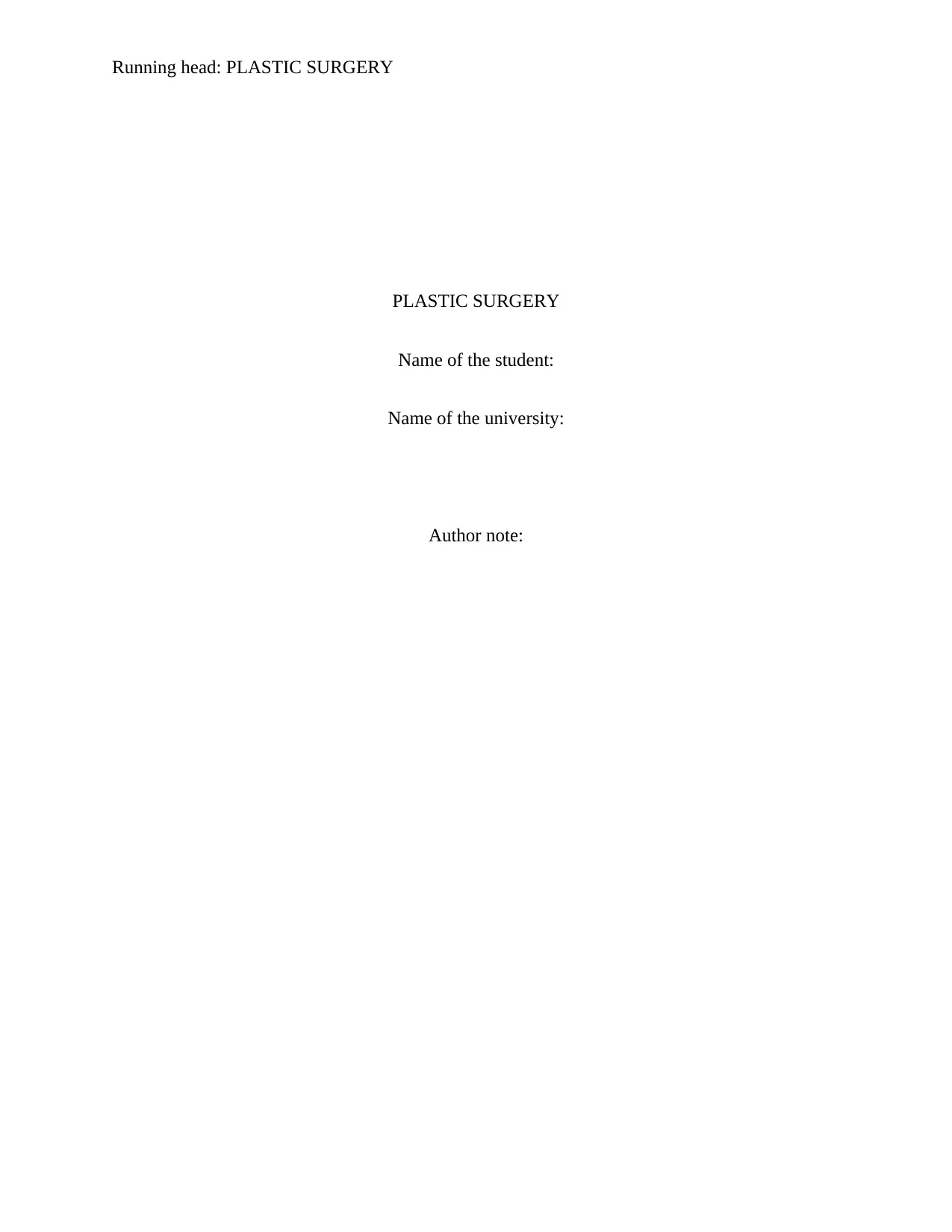
Running head: PLASTIC SURGERY
PLASTIC SURGERY
Name of the student:
Name of the university:
Author note:
PLASTIC SURGERY
Name of the student:
Name of the university:
Author note:
Paraphrase This Document
Need a fresh take? Get an instant paraphrase of this document with our AI Paraphraser
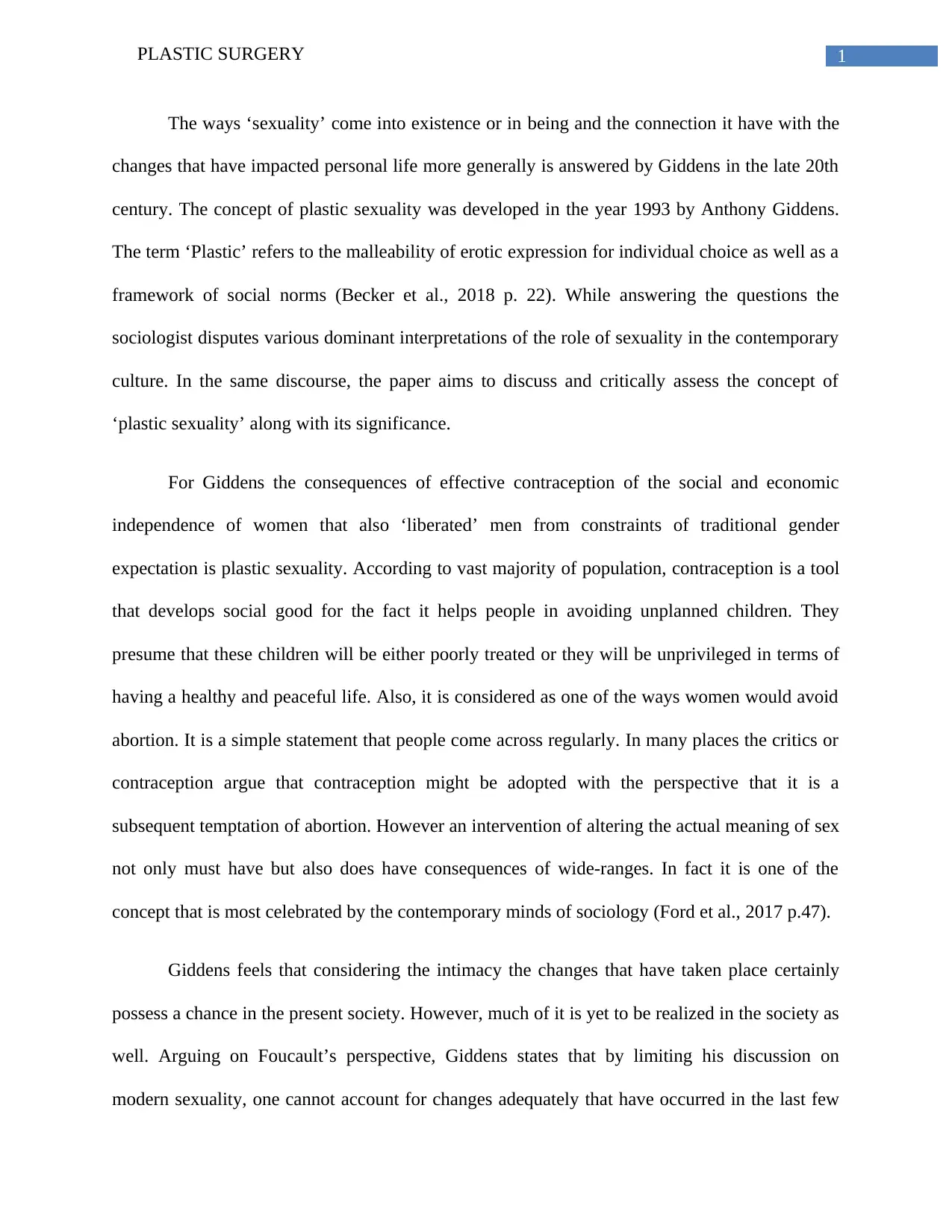
1PLASTIC SURGERY
The ways ‘sexuality’ come into existence or in being and the connection it have with the
changes that have impacted personal life more generally is answered by Giddens in the late 20th
century. The concept of plastic sexuality was developed in the year 1993 by Anthony Giddens.
The term ‘Plastic’ refers to the malleability of erotic expression for individual choice as well as a
framework of social norms (Becker et al., 2018 p. 22). While answering the questions the
sociologist disputes various dominant interpretations of the role of sexuality in the contemporary
culture. In the same discourse, the paper aims to discuss and critically assess the concept of
‘plastic sexuality’ along with its significance.
For Giddens the consequences of effective contraception of the social and economic
independence of women that also ‘liberated’ men from constraints of traditional gender
expectation is plastic sexuality. According to vast majority of population, contraception is a tool
that develops social good for the fact it helps people in avoiding unplanned children. They
presume that these children will be either poorly treated or they will be unprivileged in terms of
having a healthy and peaceful life. Also, it is considered as one of the ways women would avoid
abortion. It is a simple statement that people come across regularly. In many places the critics or
contraception argue that contraception might be adopted with the perspective that it is a
subsequent temptation of abortion. However an intervention of altering the actual meaning of sex
not only must have but also does have consequences of wide-ranges. In fact it is one of the
concept that is most celebrated by the contemporary minds of sociology (Ford et al., 2017 p.47).
Giddens feels that considering the intimacy the changes that have taken place certainly
possess a chance in the present society. However, much of it is yet to be realized in the society as
well. Arguing on Foucault’s perspective, Giddens states that by limiting his discussion on
modern sexuality, one cannot account for changes adequately that have occurred in the last few
The ways ‘sexuality’ come into existence or in being and the connection it have with the
changes that have impacted personal life more generally is answered by Giddens in the late 20th
century. The concept of plastic sexuality was developed in the year 1993 by Anthony Giddens.
The term ‘Plastic’ refers to the malleability of erotic expression for individual choice as well as a
framework of social norms (Becker et al., 2018 p. 22). While answering the questions the
sociologist disputes various dominant interpretations of the role of sexuality in the contemporary
culture. In the same discourse, the paper aims to discuss and critically assess the concept of
‘plastic sexuality’ along with its significance.
For Giddens the consequences of effective contraception of the social and economic
independence of women that also ‘liberated’ men from constraints of traditional gender
expectation is plastic sexuality. According to vast majority of population, contraception is a tool
that develops social good for the fact it helps people in avoiding unplanned children. They
presume that these children will be either poorly treated or they will be unprivileged in terms of
having a healthy and peaceful life. Also, it is considered as one of the ways women would avoid
abortion. It is a simple statement that people come across regularly. In many places the critics or
contraception argue that contraception might be adopted with the perspective that it is a
subsequent temptation of abortion. However an intervention of altering the actual meaning of sex
not only must have but also does have consequences of wide-ranges. In fact it is one of the
concept that is most celebrated by the contemporary minds of sociology (Ford et al., 2017 p.47).
Giddens feels that considering the intimacy the changes that have taken place certainly
possess a chance in the present society. However, much of it is yet to be realized in the society as
well. Arguing on Foucault’s perspective, Giddens states that by limiting his discussion on
modern sexuality, one cannot account for changes adequately that have occurred in the last few
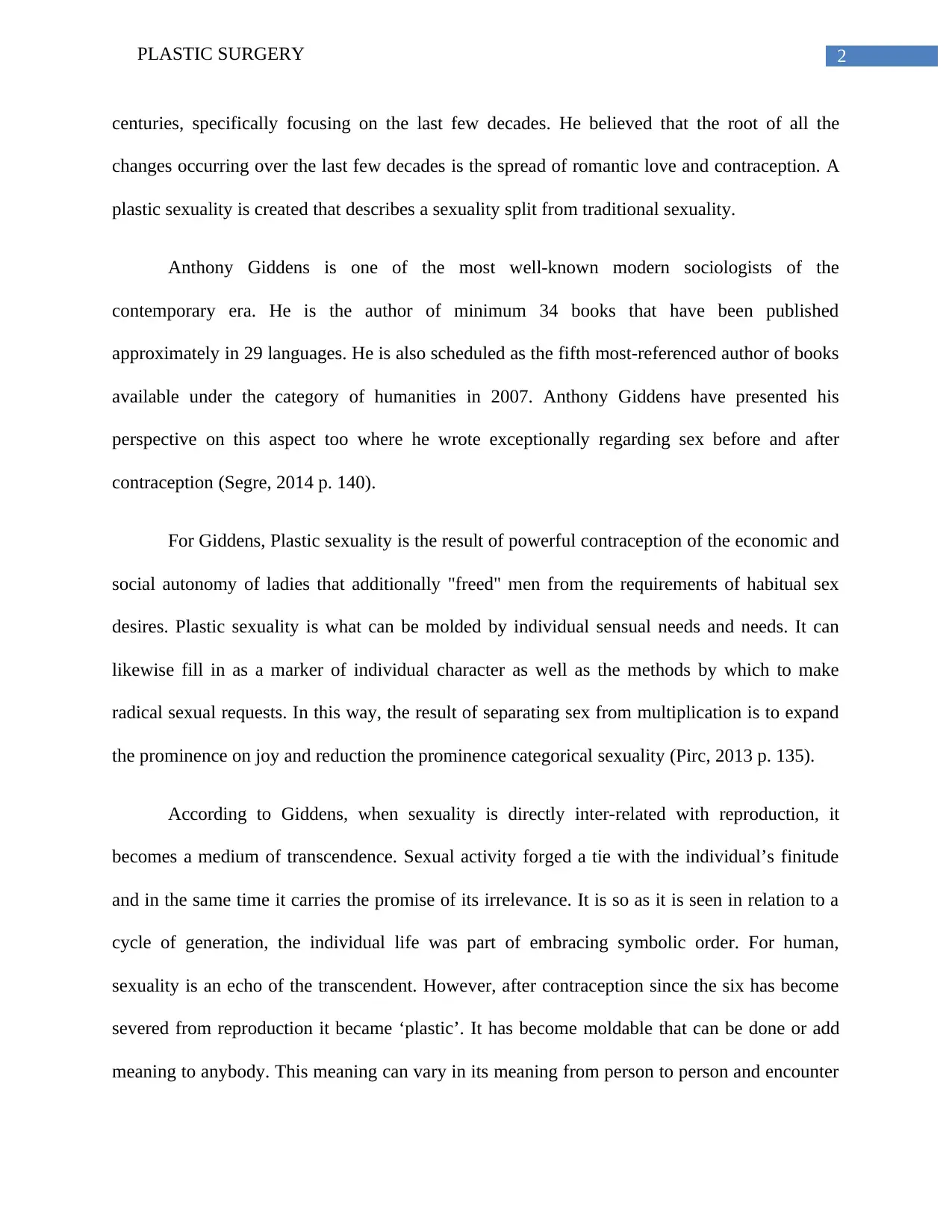
2PLASTIC SURGERY
centuries, specifically focusing on the last few decades. He believed that the root of all the
changes occurring over the last few decades is the spread of romantic love and contraception. A
plastic sexuality is created that describes a sexuality split from traditional sexuality.
Anthony Giddens is one of the most well-known modern sociologists of the
contemporary era. He is the author of minimum 34 books that have been published
approximately in 29 languages. He is also scheduled as the fifth most-referenced author of books
available under the category of humanities in 2007. Anthony Giddens have presented his
perspective on this aspect too where he wrote exceptionally regarding sex before and after
contraception (Segre, 2014 p. 140).
For Giddens, Plastic sexuality is the result of powerful contraception of the economic and
social autonomy of ladies that additionally "freed" men from the requirements of habitual sex
desires. Plastic sexuality is what can be molded by individual sensual needs and needs. It can
likewise fill in as a marker of individual character as well as the methods by which to make
radical sexual requests. In this way, the result of separating sex from multiplication is to expand
the prominence on joy and reduction the prominence categorical sexuality (Pirc, 2013 p. 135).
According to Giddens, when sexuality is directly inter-related with reproduction, it
becomes a medium of transcendence. Sexual activity forged a tie with the individual’s finitude
and in the same time it carries the promise of its irrelevance. It is so as it is seen in relation to a
cycle of generation, the individual life was part of embracing symbolic order. For human,
sexuality is an echo of the transcendent. However, after contraception since the six has become
severed from reproduction it became ‘plastic’. It has become moldable that can be done or add
meaning to anybody. This meaning can vary in its meaning from person to person and encounter
centuries, specifically focusing on the last few decades. He believed that the root of all the
changes occurring over the last few decades is the spread of romantic love and contraception. A
plastic sexuality is created that describes a sexuality split from traditional sexuality.
Anthony Giddens is one of the most well-known modern sociologists of the
contemporary era. He is the author of minimum 34 books that have been published
approximately in 29 languages. He is also scheduled as the fifth most-referenced author of books
available under the category of humanities in 2007. Anthony Giddens have presented his
perspective on this aspect too where he wrote exceptionally regarding sex before and after
contraception (Segre, 2014 p. 140).
For Giddens, Plastic sexuality is the result of powerful contraception of the economic and
social autonomy of ladies that additionally "freed" men from the requirements of habitual sex
desires. Plastic sexuality is what can be molded by individual sensual needs and needs. It can
likewise fill in as a marker of individual character as well as the methods by which to make
radical sexual requests. In this way, the result of separating sex from multiplication is to expand
the prominence on joy and reduction the prominence categorical sexuality (Pirc, 2013 p. 135).
According to Giddens, when sexuality is directly inter-related with reproduction, it
becomes a medium of transcendence. Sexual activity forged a tie with the individual’s finitude
and in the same time it carries the promise of its irrelevance. It is so as it is seen in relation to a
cycle of generation, the individual life was part of embracing symbolic order. For human,
sexuality is an echo of the transcendent. However, after contraception since the six has become
severed from reproduction it became ‘plastic’. It has become moldable that can be done or add
meaning to anybody. This meaning can vary in its meaning from person to person and encounter
⊘ This is a preview!⊘
Do you want full access?
Subscribe today to unlock all pages.

Trusted by 1+ million students worldwide
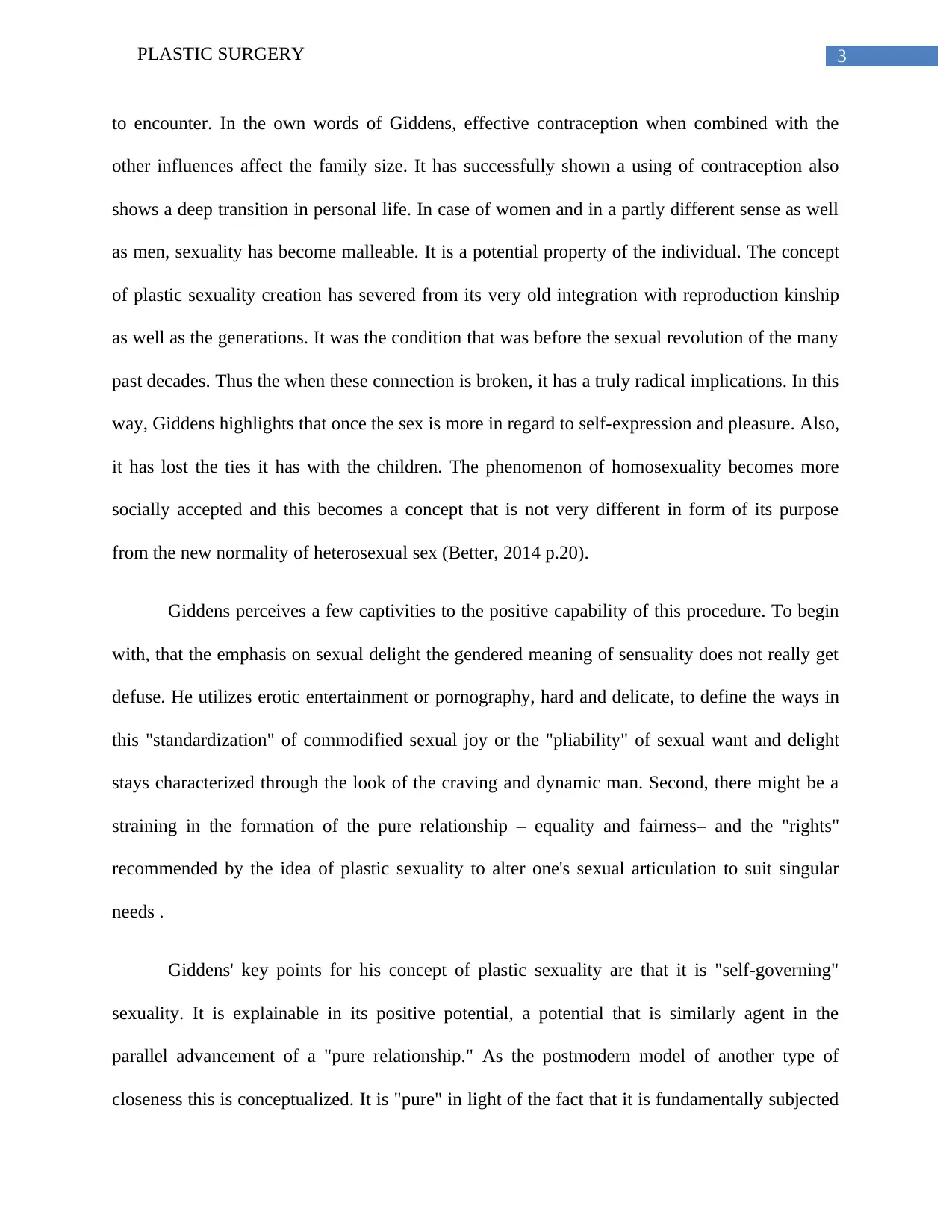
3PLASTIC SURGERY
to encounter. In the own words of Giddens, effective contraception when combined with the
other influences affect the family size. It has successfully shown a using of contraception also
shows a deep transition in personal life. In case of women and in a partly different sense as well
as men, sexuality has become malleable. It is a potential property of the individual. The concept
of plastic sexuality creation has severed from its very old integration with reproduction kinship
as well as the generations. It was the condition that was before the sexual revolution of the many
past decades. Thus the when these connection is broken, it has a truly radical implications. In this
way, Giddens highlights that once the sex is more in regard to self-expression and pleasure. Also,
it has lost the ties it has with the children. The phenomenon of homosexuality becomes more
socially accepted and this becomes a concept that is not very different in form of its purpose
from the new normality of heterosexual sex (Better, 2014 p.20).
Giddens perceives a few captivities to the positive capability of this procedure. To begin
with, that the emphasis on sexual delight the gendered meaning of sensuality does not really get
defuse. He utilizes erotic entertainment or pornography, hard and delicate, to define the ways in
this "standardization" of commodified sexual joy or the "pliability" of sexual want and delight
stays characterized through the look of the craving and dynamic man. Second, there might be a
straining in the formation of the pure relationship – equality and fairness– and the "rights"
recommended by the idea of plastic sexuality to alter one's sexual articulation to suit singular
needs .
Giddens' key points for his concept of plastic sexuality are that it is "self-governing"
sexuality. It is explainable in its positive potential, a potential that is similarly agent in the
parallel advancement of a "pure relationship." As the postmodern model of another type of
closeness this is conceptualized. It is "pure" in light of the fact that it is fundamentally subjected
to encounter. In the own words of Giddens, effective contraception when combined with the
other influences affect the family size. It has successfully shown a using of contraception also
shows a deep transition in personal life. In case of women and in a partly different sense as well
as men, sexuality has become malleable. It is a potential property of the individual. The concept
of plastic sexuality creation has severed from its very old integration with reproduction kinship
as well as the generations. It was the condition that was before the sexual revolution of the many
past decades. Thus the when these connection is broken, it has a truly radical implications. In this
way, Giddens highlights that once the sex is more in regard to self-expression and pleasure. Also,
it has lost the ties it has with the children. The phenomenon of homosexuality becomes more
socially accepted and this becomes a concept that is not very different in form of its purpose
from the new normality of heterosexual sex (Better, 2014 p.20).
Giddens perceives a few captivities to the positive capability of this procedure. To begin
with, that the emphasis on sexual delight the gendered meaning of sensuality does not really get
defuse. He utilizes erotic entertainment or pornography, hard and delicate, to define the ways in
this "standardization" of commodified sexual joy or the "pliability" of sexual want and delight
stays characterized through the look of the craving and dynamic man. Second, there might be a
straining in the formation of the pure relationship – equality and fairness– and the "rights"
recommended by the idea of plastic sexuality to alter one's sexual articulation to suit singular
needs .
Giddens' key points for his concept of plastic sexuality are that it is "self-governing"
sexuality. It is explainable in its positive potential, a potential that is similarly agent in the
parallel advancement of a "pure relationship." As the postmodern model of another type of
closeness this is conceptualized. It is "pure" in light of the fact that it is fundamentally subjected
Paraphrase This Document
Need a fresh take? Get an instant paraphrase of this document with our AI Paraphraser
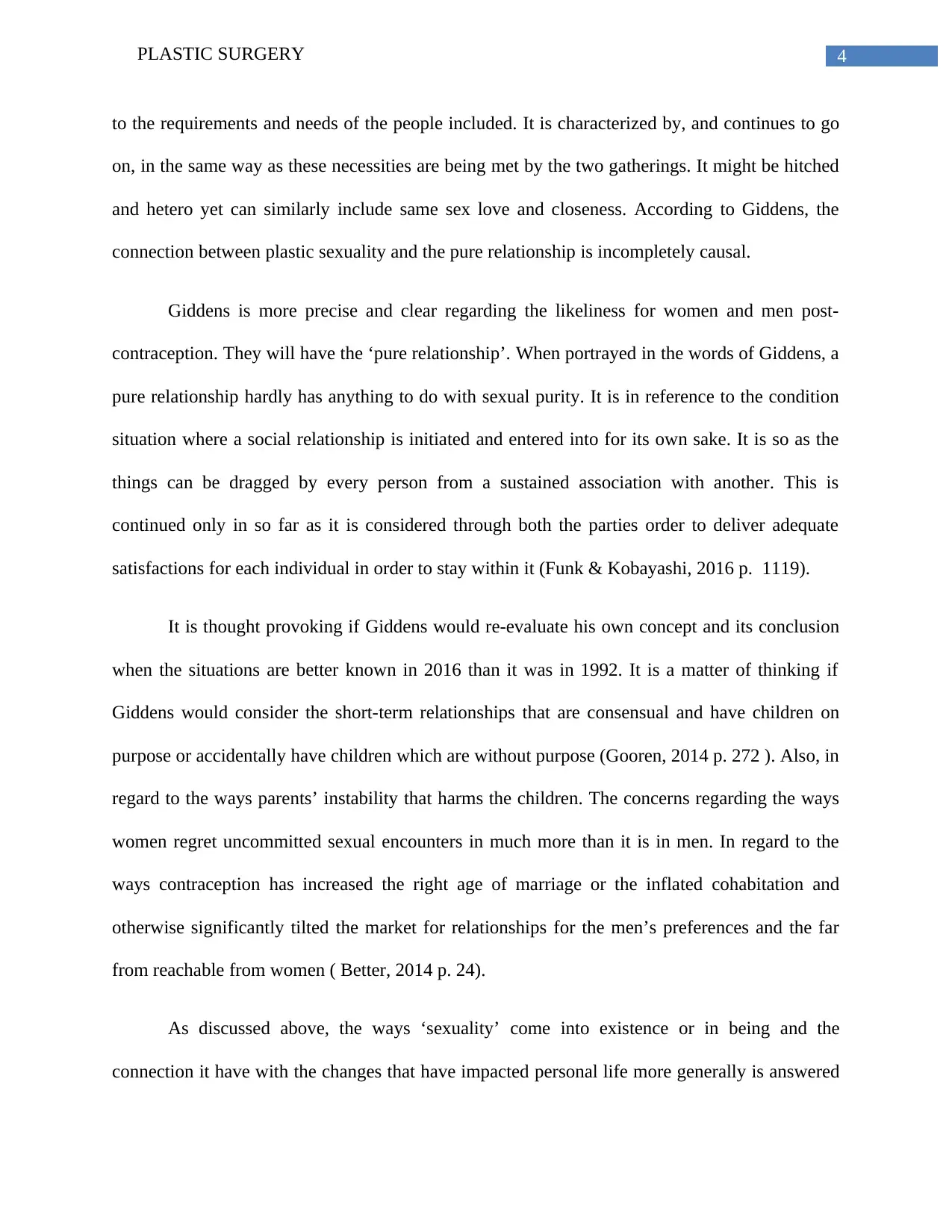
4PLASTIC SURGERY
to the requirements and needs of the people included. It is characterized by, and continues to go
on, in the same way as these necessities are being met by the two gatherings. It might be hitched
and hetero yet can similarly include same sex love and closeness. According to Giddens, the
connection between plastic sexuality and the pure relationship is incompletely causal.
Giddens is more precise and clear regarding the likeliness for women and men post-
contraception. They will have the ‘pure relationship’. When portrayed in the words of Giddens, a
pure relationship hardly has anything to do with sexual purity. It is in reference to the condition
situation where a social relationship is initiated and entered into for its own sake. It is so as the
things can be dragged by every person from a sustained association with another. This is
continued only in so far as it is considered through both the parties order to deliver adequate
satisfactions for each individual in order to stay within it (Funk & Kobayashi, 2016 p. 1119).
It is thought provoking if Giddens would re-evaluate his own concept and its conclusion
when the situations are better known in 2016 than it was in 1992. It is a matter of thinking if
Giddens would consider the short-term relationships that are consensual and have children on
purpose or accidentally have children which are without purpose (Gooren, 2014 p. 272 ). Also, in
regard to the ways parents’ instability that harms the children. The concerns regarding the ways
women regret uncommitted sexual encounters in much more than it is in men. In regard to the
ways contraception has increased the right age of marriage or the inflated cohabitation and
otherwise significantly tilted the market for relationships for the men’s preferences and the far
from reachable from women ( Better, 2014 p. 24).
As discussed above, the ways ‘sexuality’ come into existence or in being and the
connection it have with the changes that have impacted personal life more generally is answered
to the requirements and needs of the people included. It is characterized by, and continues to go
on, in the same way as these necessities are being met by the two gatherings. It might be hitched
and hetero yet can similarly include same sex love and closeness. According to Giddens, the
connection between plastic sexuality and the pure relationship is incompletely causal.
Giddens is more precise and clear regarding the likeliness for women and men post-
contraception. They will have the ‘pure relationship’. When portrayed in the words of Giddens, a
pure relationship hardly has anything to do with sexual purity. It is in reference to the condition
situation where a social relationship is initiated and entered into for its own sake. It is so as the
things can be dragged by every person from a sustained association with another. This is
continued only in so far as it is considered through both the parties order to deliver adequate
satisfactions for each individual in order to stay within it (Funk & Kobayashi, 2016 p. 1119).
It is thought provoking if Giddens would re-evaluate his own concept and its conclusion
when the situations are better known in 2016 than it was in 1992. It is a matter of thinking if
Giddens would consider the short-term relationships that are consensual and have children on
purpose or accidentally have children which are without purpose (Gooren, 2014 p. 272 ). Also, in
regard to the ways parents’ instability that harms the children. The concerns regarding the ways
women regret uncommitted sexual encounters in much more than it is in men. In regard to the
ways contraception has increased the right age of marriage or the inflated cohabitation and
otherwise significantly tilted the market for relationships for the men’s preferences and the far
from reachable from women ( Better, 2014 p. 24).
As discussed above, the ways ‘sexuality’ come into existence or in being and the
connection it have with the changes that have impacted personal life more generally is answered

5PLASTIC SURGERY
by Giddens in the late 20th century. Giddens' key points for his concept of plastic sexuality are
that it is "self-governing" sexuality. However, there is need of evaluating the theory and the
concept he has developed. The concept as per the 1992 is certainly thought provoking and new
however in the 2019 the things have changed much beyond imagination in regard to relationship.
Therefore, it is significant to reconsider the concept as per the 21st century relationships.
by Giddens in the late 20th century. Giddens' key points for his concept of plastic sexuality are
that it is "self-governing" sexuality. However, there is need of evaluating the theory and the
concept he has developed. The concept as per the 1992 is certainly thought provoking and new
however in the 2019 the things have changed much beyond imagination in regard to relationship.
Therefore, it is significant to reconsider the concept as per the 21st century relationships.
⊘ This is a preview!⊘
Do you want full access?
Subscribe today to unlock all pages.

Trusted by 1+ million students worldwide
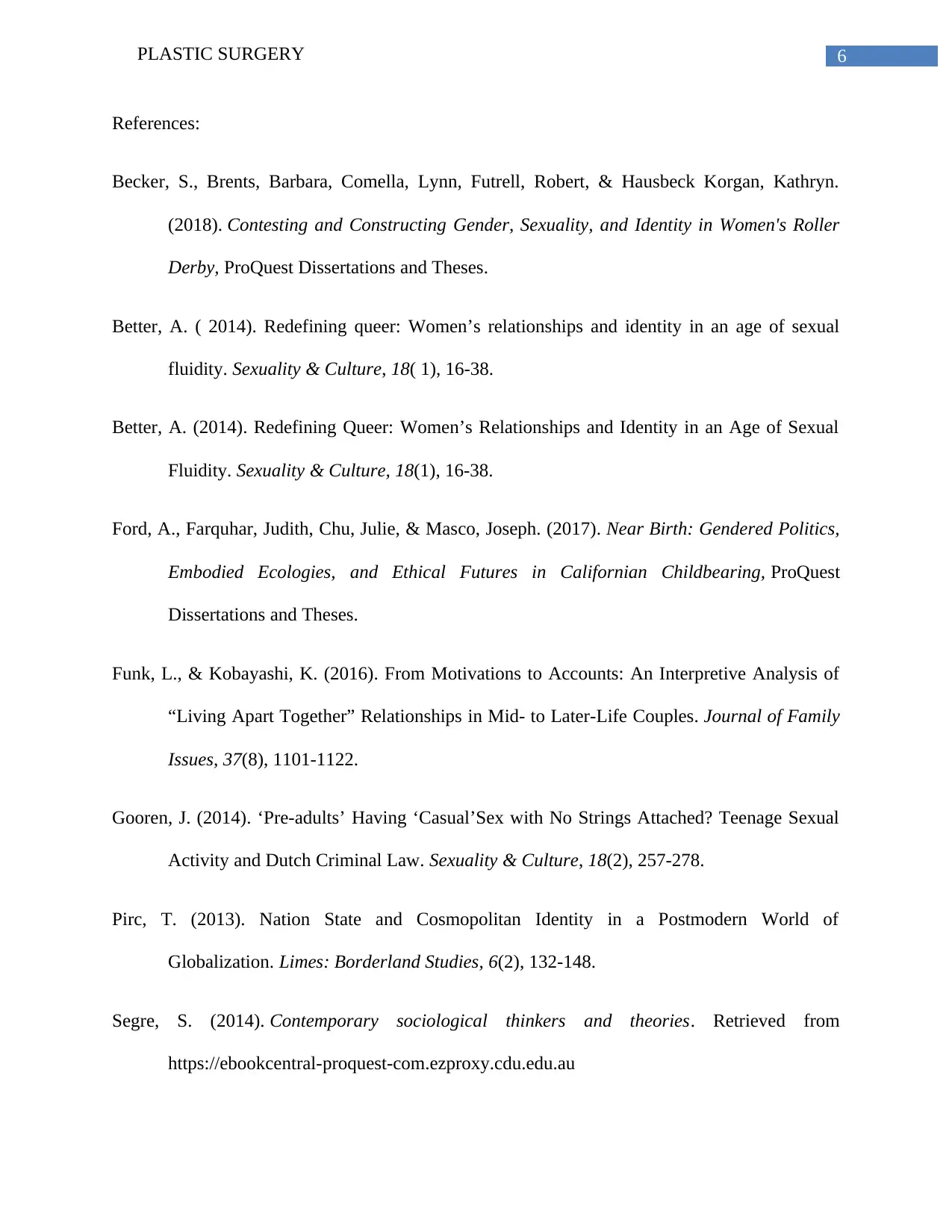
6PLASTIC SURGERY
References:
Becker, S., Brents, Barbara, Comella, Lynn, Futrell, Robert, & Hausbeck Korgan, Kathryn.
(2018). Contesting and Constructing Gender, Sexuality, and Identity in Women's Roller
Derby, ProQuest Dissertations and Theses.
Better, A. ( 2014). Redefining queer: Women’s relationships and identity in an age of sexual
fluidity. Sexuality & Culture, 18( 1), 16-38.
Better, A. (2014). Redefining Queer: Women’s Relationships and Identity in an Age of Sexual
Fluidity. Sexuality & Culture, 18(1), 16-38.
Ford, A., Farquhar, Judith, Chu, Julie, & Masco, Joseph. (2017). Near Birth: Gendered Politics,
Embodied Ecologies, and Ethical Futures in Californian Childbearing, ProQuest
Dissertations and Theses.
Funk, L., & Kobayashi, K. (2016). From Motivations to Accounts: An Interpretive Analysis of
“Living Apart Together” Relationships in Mid- to Later-Life Couples. Journal of Family
Issues, 37(8), 1101-1122.
Gooren, J. (2014). ‘Pre-adults’ Having ‘Casual’Sex with No Strings Attached? Teenage Sexual
Activity and Dutch Criminal Law. Sexuality & Culture, 18(2), 257-278.
Pirc, T. (2013). Nation State and Cosmopolitan Identity in a Postmodern World of
Globalization. Limes: Borderland Studies, 6(2), 132-148.
Segre, S. (2014). Contemporary sociological thinkers and theories. Retrieved from
https://ebookcentral-proquest-com.ezproxy.cdu.edu.au
References:
Becker, S., Brents, Barbara, Comella, Lynn, Futrell, Robert, & Hausbeck Korgan, Kathryn.
(2018). Contesting and Constructing Gender, Sexuality, and Identity in Women's Roller
Derby, ProQuest Dissertations and Theses.
Better, A. ( 2014). Redefining queer: Women’s relationships and identity in an age of sexual
fluidity. Sexuality & Culture, 18( 1), 16-38.
Better, A. (2014). Redefining Queer: Women’s Relationships and Identity in an Age of Sexual
Fluidity. Sexuality & Culture, 18(1), 16-38.
Ford, A., Farquhar, Judith, Chu, Julie, & Masco, Joseph. (2017). Near Birth: Gendered Politics,
Embodied Ecologies, and Ethical Futures in Californian Childbearing, ProQuest
Dissertations and Theses.
Funk, L., & Kobayashi, K. (2016). From Motivations to Accounts: An Interpretive Analysis of
“Living Apart Together” Relationships in Mid- to Later-Life Couples. Journal of Family
Issues, 37(8), 1101-1122.
Gooren, J. (2014). ‘Pre-adults’ Having ‘Casual’Sex with No Strings Attached? Teenage Sexual
Activity and Dutch Criminal Law. Sexuality & Culture, 18(2), 257-278.
Pirc, T. (2013). Nation State and Cosmopolitan Identity in a Postmodern World of
Globalization. Limes: Borderland Studies, 6(2), 132-148.
Segre, S. (2014). Contemporary sociological thinkers and theories. Retrieved from
https://ebookcentral-proquest-com.ezproxy.cdu.edu.au
1 out of 7
Your All-in-One AI-Powered Toolkit for Academic Success.
+13062052269
info@desklib.com
Available 24*7 on WhatsApp / Email
![[object Object]](/_next/static/media/star-bottom.7253800d.svg)
Unlock your academic potential
Copyright © 2020–2025 A2Z Services. All Rights Reserved. Developed and managed by ZUCOL.